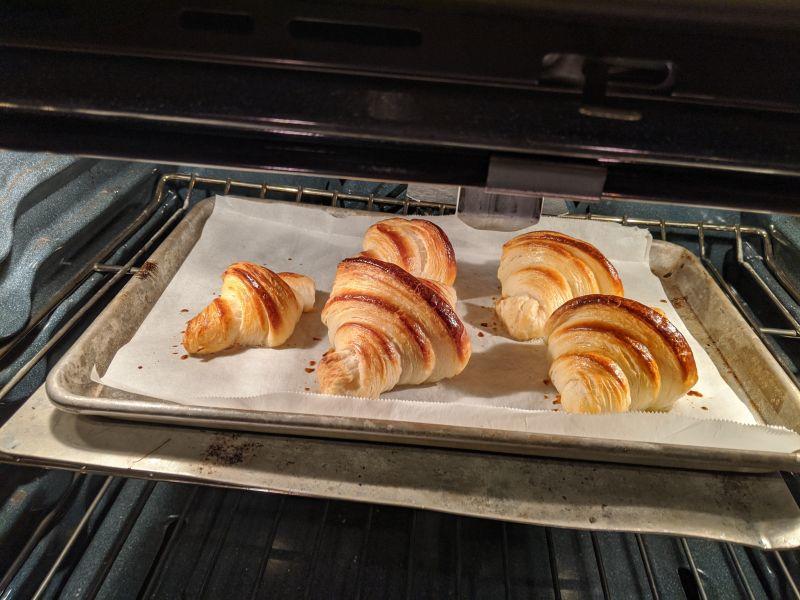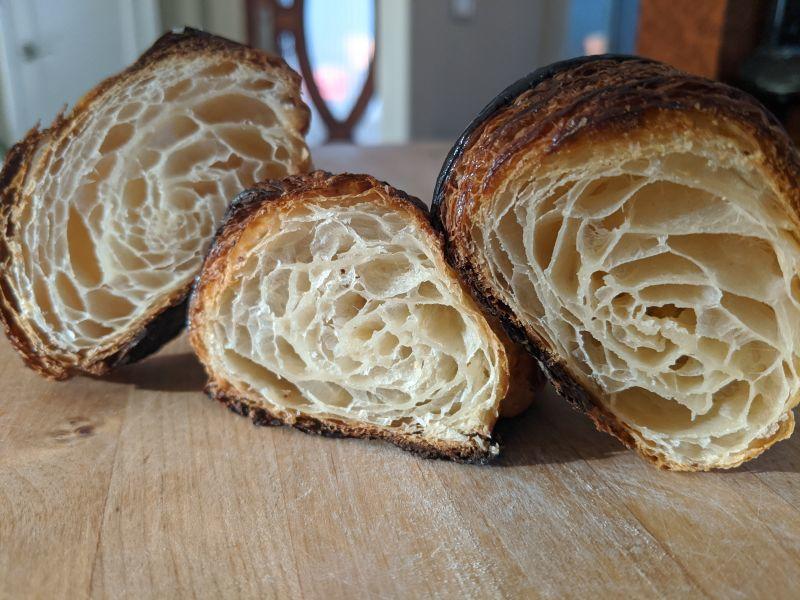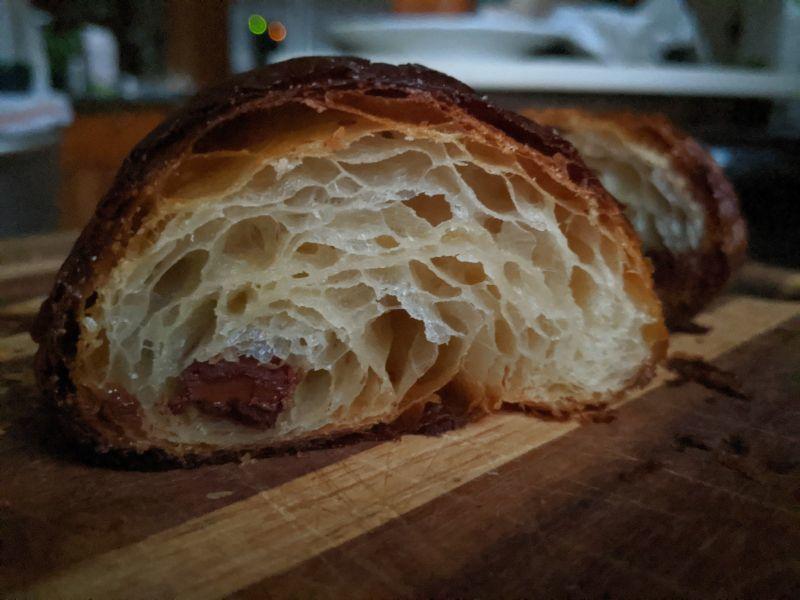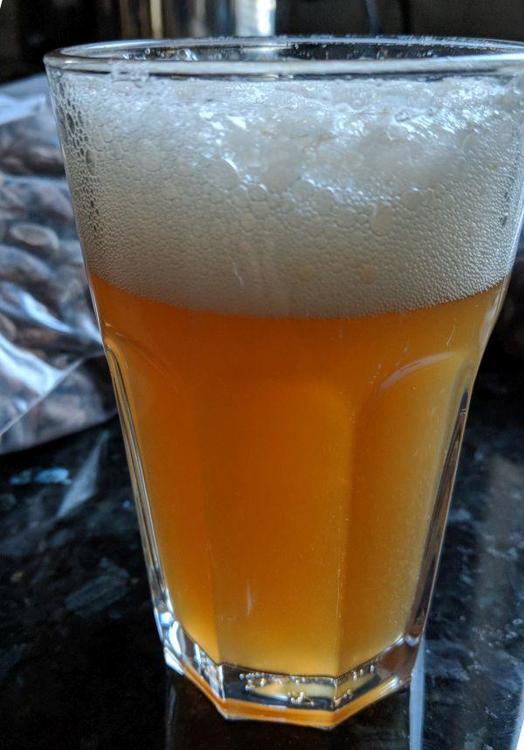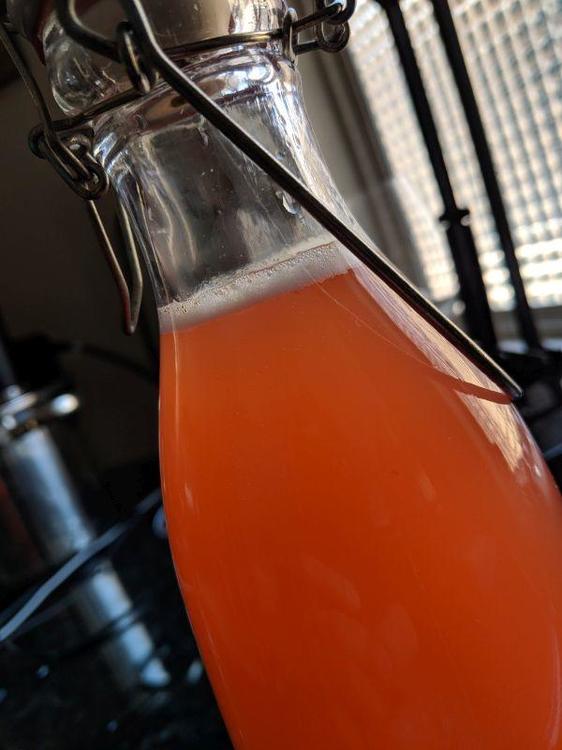
jedovaty
participating member-
Posts
445 -
Joined
-
Last visited
Content Type
Profiles
Forums
Store
Help Articles
Everything posted by jedovaty
-
2+ year old duck breast from back depths of freezer + porcini mushroom ravioli in yuzu marmelade "sauce"**. Skin fried separate to get it crispy as a topping, can't really see it in the photo. First time making ravioli, second time making filled pasta. Filling was a little dry and bland, the sauce really helped. **duck fat, onion, marjoram, chopped tomato, garlic leaves, pat butter, and a couple plops of yuzu marmelade.
-
It looks like you've been doing research, so I'm sure you've come across the outdoor propane wok burners. They have upwards or exceed 100k btu, usually don't come with a stand. If you have any asian-centric areas like a chinatown or japantown nearby, go browse stores after the shut-ins are lifted and you'll find one, and can even haggle if that's your thing. On line they seem to have gone up in price compared to 10 years ago. I picked mine up in "Little Saigon" near my old house, haggled price down because of the rat poop in the box. Given that, please take a moment to consider my personal PSA on these stoves. They are a pain in the ass to use, ridiculously powerful, and will get a literal wok HEY out of you if you get them screaming hot and drop a little oil in with no experience. Don't ask how I know 🙈🙉🙊 What I learned: these kinds of burners are awesome fun, but in the long run the whole stir-fry thing may not be worth the effort. As simple as it looks, it really takes a lot of experience to get it right and consistent, more so than a lot of other cooking. Cleanup is awful (grease splatters everywhere), you'll end up with undercooked or overcooked food half the time, the danger is real, and you really have to use a lot more oil than traditional stove saute/stir-frying. Now, if you can set it up outside with plenty of dirt or grass surrounding your station, or, inside with a flowing water wall and a night-shift cleaning crew, go for it 👍 Remember the fire extinguisher. Seriously. PS: please note, this is based on my experiences, I gave it a legitimate go for 2-3 months, and eventually figured out a successful work flow. I'm sure there are more experienced home cooks or chefs who can chime in and confirm there aren't issues and I was likely doing things wrong blah blah blah, but no one is going to convince me to go back 😝. I found the "hey" component not worth the effort.
-
Your Daily Sweets: What Are You Making and Baking? (2017 – )
jedovaty replied to a topic in Pastry & Baking
Holy crap. I'll have you know, I almost clicked "report post" 😝 -
If it's been frozen that long, then it would make sense to pursue a more processed product, rather than a simple sear to medium rare/medium. It was an expensive duck (and the other parts were tasty, iirc), so, I'd like to at least try something. Forgot to mention, I also have fish sauce, mirin, mustard, rice wine vinegar, apple cider vinegar, but no soy sauce. I just found yuzu jam and honey. Garlic's not ready for harvest, but I can use a few of the leaf sprouts in a pinch. I wonder if I could try smoking it on my gas grill.. it does go down low to about 200F, and I've got some woodchips and lump charcoal. Other ideas floating in my head now, hmmm.
-
I'm nearly through the freezer! There's a vac-sealed duck breast that was initially intended for sous vide to 135F and sear, but sadly forgotten and been there for over 2 years. It has some ice build up in the package. Safe to eat? What should I make, if so? Pantry items are running low: five small cans of tomato paste (wtf), a handful of dried porcinis , an onion, package of wakame, 1lb unroasted cacao beans, some gelatin, lots of flour, oats, buckwheat, sugar, some quinoa and rice, one can of garbanzo beans, and a small package of shredded coconut. I have some green onion in the garden as well, and can pick up fresh kale from my neighbor's garden. Eggs and butter in the fridge, two carrots, garbanzo miso, and a small package of frozen cauliflower florets. Hmmmm. One-person soup or stew? Chop up for ravioli filling?
-
I temporarily permanently borrowed my mom's viking pro 7 qt, along with the meat grinder and sausage maker attachment. I don't think the brands are compatible without some sort of adapter. I'll just run oats through my vitamix or grinder, no big. Actually.. hmmm... I wonder if the indian wet grinder would work for something dry, just in short bursts? That does squishing and sheering action. Hmmm!
-
I really wish they made the rollers interchangeable on these machines, not only could you clean it, but imagine if they offered a textured roller, then you could do things like roll oats.
-
HEY, yes we do 😛 I'm not going to mansplain it to you (*head bob*), but I hope you give it another try Try the method in the second video I put earlier in this thread, it works! FWIW, the cutters are pointless, easier to just hand cut everything provided knife or pizza cutter is sharp. When I went through my gluten-free phase, I spent an hour getting fubar dried buckwheat dough out of the cutters.. that was not fun.
-
Teo mentioned the fish in his post. It's not that I want one. I needs it. Are these things kept on like a fridge, or, do you turn it on as needed?
-
How about using it to kill weavils in grains, seeds, flours, etc? Why am I reading this thread.
-
Inspired by this thread, I rolled and shaped tortellini from egg pasta dough. Filling was a mixture of buffalo mozzarella, manchego, romano, egg and fresh oregano. Homemade simple red sauce from canned tomatoes over sauteed onions, garlic, and marjoram. I'm sure italian grandmas were rolling over in their graves frantically waving their arms about.. but my dudes and dudettes, this was tasty!! Not to mention way easier than expected It was a little tedious making the little turd-elinis [🤪]. If anyone's on the fence, just give it a try! Thanks @Kim Shook!
-
Oooooo just added to my wish list, right behind a chamber vac sealer and a touchless kitchen faucet
-
I tried Portos last year for the first time - food is worth the travesty of that parking lot in BP. I am exploring delivery options now, no thanks to you
-
I've brought a batch to work (no vegetarians in my office, I checked), and labelled them as "experiment #3782.5c" without listing any ingredients. Well received, no one noticed anything different. I could taste it, but then, I was looking for it. Back to bacon, @Katie Meadow it actually doesn't take all that much bacon to make 3/4 cup, but holy cow the proportion is crazy, by weight more than 50%! And then the sugar.. wow. This was a stupid year to give up beef and pork 😢
-
Okay, I'll be the guy that says it (and has done it): swap out a tablespoon of butter for bacon grease or duck/goose fat in cookies, pastries, desserts, etc... Don't do too much, just a hint 🤤
-
@Kim Shook I've made a lot of pasta as a "home cook" just for myself, and I prefer the mix of 00 or a lower-protein all purpose with higher % of durum (e.g. bob's red mill). Here are three videos that I've shared with a few friends and co-workers recently who are new to pasta making, and all found them super helpful. I wish I could find the original, full Jamie Oliver video video - it was pivotal in inspiring me to learn how to cook Quick pasta by Jamie Oliver, the keep it simple method: https://www.youtube.com/watch?v=upi5SkWXeBM Full technique if you are into learning details (the flour she recommends is expensive and just stick with easy to get stuff): https://www.youtube.com/watch?v=m_fu5RaXMVk and finally hand shaping without the machine, this is a lot of fun, even if a bit long :https://www.youtube.com/watch?v=Ew-3-8itpjc Enjoy and have fun
-
Hi: I ended up having to put laminating mass into the fridge because the dough became too soft, while the butter was correct consistency. Refrigerating the dough with the recipe I'm using helped stiffen it and made the rolling better. Most important take-away: the final proof is likely the most important element of this. This time final proof pushed to 7 hours at 74F/23C - this is a sourdough leavened dough, with tiny amount of SAF gold. Here's why I believe this to be the case: last night's practice batch was problematic during lamination, first because I used a new butter (fernani italian cream, 82%, it's all costco had?!), second, the butter did turtle-shell in the first rolling, third, the dough stretched further than expected, and fourth, at one point the dough cracked along the sides. To make things fit, I cut the dough, but miscalculated and ended up patching things with left over scraps. Some of the patching was messy, I was tired and frustrated. Given the odd lengths, I did some variation of 2 sets of double folds, followed by a single tri-fold. Prior practice batches were all three sets of tri-folds. Baking was done in two batches: the first higher up in oven, however, the bottoms still burned. The second, finally figured out what it takes to bake without burning: specific position, temperature, rimmed baking sheet on top of a cookie sheet. Photo shows second batch mid-bake.. absolutely no butter leaking!! Second picture shows crumb of three burnt-bottom croissants from the first batch.. the crumb isn't bad at all, despite all the laminating problems. Therefore, I still believe the final proof is most important. The rest of the technique is what will likely make them perfect, but I think I am going to stress less about the lamination, it just became far too frustrating.
-
Understood, thank you.
-
Hi: Do I need to refrigerate croissant dough between turns if the ambient temperature in my house is low, i.e. 19C (66F) or below? For example, it is 15C/59F right now in my house. Rest between turns is important to let the dough "relax", and generally people put the dough in the fridge to keep butter from melting and absorbing into the tough since homes are usually over 22C/70F. If it's this cold here won't it be better to leave the dough out for the sake of the butter? Or perhaps it is even too cold for butter to actually get soft enough to roll out? I may give it try, because last time I had a little difficulty rolling it out smoothly. The butter cracked and look like a turtle shell under the dough, and I thought I was rushing it, despite waiting 30 minutes or so after pulling dough out of the fridge following a rest. But now it seems like maybe it's just too cold for the butter to be at the right temp to roll out... hmmm. My results were still pretty good, maybe smooth butter rolling isn't as crucial as clean edges and proper final proof. Thanks for your time!
-
Your Daily Sweets: What Are You Making and Baking? (2017 – )
jedovaty replied to a topic in Pastry & Baking
Sourdough croissants spiked with small amount of SAF gold. Bottoms nearly burnt, need to raise one up in the oven and lower temp 25F. The exterior of the PaC not pictured, baked on another pan that was too high and outside totally burnt hahah. The "acceptable" crumb really surprised me, because I rushed the lamination, which caused the butter to tortise-shell in the first two turns - I kept at it to see what would happen so I could learn to diagnose mistakes, and glad I didn't just junk the whole thing -
Katie: here's a starting point for you: 100g sugar to 1kg water (aka 1 liter water), and ginger can be anywhere from a couple small knobs to an entire "hand" of it. Start with that, then adjust next time if you find it too sweet or not sweet enough. The ginger part is a little tough, because sometimes the ginger is very strong and other times it is not. You can make ginger beer/ale in three ways: - concentrated simple syrup, and dilute with carbonated water; or - a ginger bug (naturally fermented); or - commercial yeast - most recommended is champagne yeast I've done all three. I really like a sharp, burning ginger beer, so I tend to use an entire hand. Alton Brown has an episode on making ginger ale with champagne yeast. https://www.foodnetwork.com/recipes/alton-brown/ginger-ale-recipe-1944722 You can speed down the chilling time by using half the water and pouring over equal amount of ice. Super easy
-
I posted about it last month in this topic: https://forums.egullet.org/topic/160387-eg-cook-off-84-ginger/page/2/?tab=comments#comment-2234730 Here is a ginger beer that had lots of foam, and a bottled strawberry soda made with ginger bug. I wish I could figure out what's going on and why the sodas have failed the last couple years
-
Try using fennel bulb in braised cabbage! It's awesome!
-
If it's a gelatinous stock, you can go even further and reduce down to a "fruit-leather" like stage, which freezes well and becomes a sort of homemade bouillon. Trouble is that it's kind of tough to work with initially.. helps to use a non-stick pan.
-
I like fresh ginger and turmeric grated and steeped in water at roughly 180F for 5-10 minutes, as an excellent cough/cold/flu relief; honey and lemon can of course be added. On a strange whim a while back, I mixed some into whole-groat buckwheat porridge with a splash of maple syrup, and it was strangely satisfying. While not cooked, what about ginger ale/beer? I used to grow a naturally fermented bug late spring and made some tasty ginger beers throughout summer and into fall. For some strange reason, however, my last several attempts have all failed. My process is: grow bug (mix grated organic ginger into filtered water with some sugar, add a little ginger and sugar daily until very fizzy and white stuff on bottom), then use about 1/4c into 1-2 L room-temp homemade flavored syrup (ginger, pineapple, strawberry, peach, melon, vanilla, whatever). Let this begin bubbling, then bottle, and drink/fridge once enough pressure has been built in the bottles. The bug seems to fail at the step when mixing with syrup, I don't know why. But, if you all haven't tried this, highly recommended!






